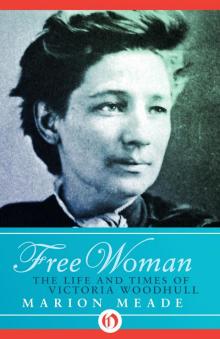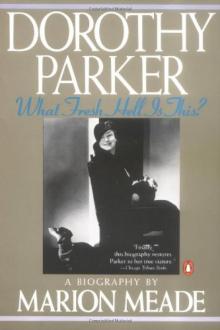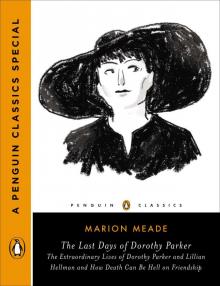- Home
- Marion Meade
Unruly Life of Woody Allen Page 2
Unruly Life of Woody Allen Read online
Page 2
Besides considerable gifts as an artist, he excelled at confecting his own personal mythology. His most marvelous accomplishment was "Woody Allen," an extremely intricate, layered work composed of autobiography, masterful marketing, and good old-fashioned show business. On stage and screen, he always played the same lovable, self-mocking character, exactly as Chaplin kept portraying his mischievous Little Tramp throughout much of his career. And while Chaplin fans knew better than to confuse the performer with his performance, there was a blurring of the line between Woody and his fictional character, an ageless Peter Pan, endlessly self-deprecating and over-analyzing.
By January 13, 1992, the fictionalized Woody Allen had been enshrined as America’s comic sweetheart for as long as most people could remember. As the Ingrid Bergman of film comedians, he was a moral paragon, sanctified beyond all common sense as America's favorite comedy saint by adoring fans who believed he could do no wrong. "Woody Allen, c'est moi," argued the critic Richard Schickel, one of his earliest supporters, who claimed to know instinctively "where he's coming from and, equally instinctively, I have some sense of where he's going."
While professionals such as Schickel continued to analyze Woody's comic experiments, we simple fans loved his films wholeheartedly. We knew that each year he would turn out some utterly fresh delight, and we rushed to see his latest creation as soon as it opened. In our excitement, we thought nothing of waiting in lines that snaked around the block; indeed, this ritual was apparently part of the price of admission. Afterward, we emerged smiling and feeling good, eager to pass along the most delicious bits to our friends. Usually we went back to see his films a second and third time because they were truly worth viewing again. If we were lucky, an art house might run a Woody film festival, or a film society screen a retrospective. With the coming of VCRs, when all the old favorites could be enjoyed again at home, we took the opportunity to introduce our children to movies such as Sleeper.
As to his feelings about us, the question appeared to be curiously answered in Stardust Memories, in which he painted his affectionate fans as ghouls. That didn't mean we abandoned him. Instead, we automatically struggled to understand the wretchedness that drove him. When in that film somebody accuses his character of being an atheist, he retorted, "To you, I'm an atheist. To God, I'm the loyal opposition." That grouchy response seemed to explain everything, more or less. Still, baffling or not, he was our national treasure, not because he always made great films but because he was invariably fascinating, even when he failed. So we paid no attention to what reviewers wrote. Whether Vincent Canby composed a love letter or a truculent Pauline Kael tore a movie to bits did not seem to matter. The important question was: What would he think of next? Would he skid ahead to 2173 and become a household robot? Could he top his chase of an immense terrorist breast over hill and dale before capturing it with an equally immense bra? Get himself executed in Czarist Russia and return to life with a report that death isn't so horrible, at least no worse than an evening with an insurance salesman? Who else but Woody could possibly have imagined diving into a male body during intercourse, as a timid sperm nervously awaiting ejaculation?
Throughout his nearly three decades of celebrity, no scandal ever smudged his golden reputation, almost an impossibility in the entertainment industry, where the road between fame and the dead end of a career is pocked with land mines. Indeed, if any show business figure seemed blessed with a healthy bank account of public affection, it was Woody. The notion that he might be capable of committing a dishonorable act was hard to imagine. We had no doubts that the real Woody was somewhat, but not very, different from the autobiographical character on screen; and while he seemed just like us, we also conjectured that he had to be different, more sensitive, more of a perfectionist and a depressive, and probably a lot nuttier than we were. In Annie Hall, young Alvy Singer's fear that the universe is expanding causes his mother to yell in exasperation, "What is that your business?!" Like the baffled Mrs. Singer, we didn't understand what made him tick either—but we accepted him on faith because we liked and trusted him. The obvious integrity of his conduct made him "one of the good guys," said his friend Walter Bernstein. Certainly we had no doubt about his worth as an artist. He was what the political writer Arthur Schlesinger Jr. referred to as "the most original comic genius in American films since Chaplin and Keaton." To which we said amen.
On that warm rainy night in January 1992, it must have been pretty hard to appreciate the significance of what had just happened. That Mia would be deeply hurt was to be expected. He knew that whenever they fought, calls immediately went forth to the telephone company and a locksmith. He knew it never took more than a few days before she forgave him and turned over the new number and key. This crisis over Soon-Yi was different, of course. Mia would put him through hell for a while. Even so, past experience suggested that it, too, would blow over eventually.
CHAPTER ONE
God and Carpeting
Chapter One. He was as tough and romantic as the city he loved. Behind his black-rimmed glasses was the coiled sexual power of a jungle cat.... New York was his town. And it always would be.
So go the opening lines of Manhattan, one of the twenty-nine pictures that, all together, form a cumulative portrait of Woody Allen s life— documents comparable in obsession if not in depth to the seven volumes of Marcel Proust's Remembrance of Things Past. His most hugely popular film, as well as his biggest commercial success, Manhattan is Woody's anthem to the island, not the whole of it but a particular slice that he likes to call "the Zone." The exclusive Silk Stocking District of New York's Upper East Side runs north-south from Ninety-sixth Street to Fifty-ninth, and from Fifth Avenue to the East River. In the 10021 ZIP code area, there is a little swath of real estate—perhaps a half-dozen blocks below Seventy-second Street—where the median family income of homeowners is more than $700,000 a year. This is Woody Allen country, where there is no squalor or deprivation, no immigrants, virtually no blacks or Latinos in view except those wearing uniforms, and little crime that doesn't involve property. The typical criminal is a snatcher of gold chains.
The very first time Woody Allen set foot in the Upper East Side he was a small boy, trailing saucer-eyed behind his father, up and down leafy boulevards where middle-aged English nannies wheeled brand-new English baby carriages and great swatches of scarlet and gold spring tulips floated up the middle of Park Avenue. In this place that seemed to be his spiritual home, the adult Woody later recalled thinking that there was "something wonderful about the way the streets feel here," and those feelings have stayed with him throughout the years.
Whenever he leaves his home, in his rumpled khaki chinos and pullover sweater, he is able to curl back into his dreams of yesteryear and surround himself with the remembered tableaux of those nannies trudging past the uniformed doormen and chauffeurs. In sixty years, the streets have changed very little. It is he who has traversed far beyond his romantic fantasies to become the district's very own poet laureate.
Deep in the heart of Brooklyn, south of Flatbush, is the neighborhood of Midwood. The distance between the buildings along upper Fifth Avenue and the candy stores of Avenue J, Midwood’s major thoroughfare, is barely more than twelve miles. Measured by subway stops, Midwood is twenty stations away on the D train that rumbles across the Manhattan Bridge. By car, the trip is an easy thirty-two minutes. But the two areas might as well be a thousand miles apart. Midwood in the 1930s was a comfortably middle-class, upwardly mobile, heterogenous neighborhood of mostly Jews and a few Italians. On the quiet, tree-lined blocks were small semidetached houses; on the cross streets, the typical sturdy six-floor apartment buildings; and to the east between Coney Island Avenue and Ocean Parkway, the expensive homes. From the raucous markets of Avenue J wafted the dizzying smells of buttery dough: crunchy, dense rye breads, gooey rugelach oozing raspberry jam, as well as delicious cinnamon-laced babkas. To their oilcloth-covered tables in freshly mopped linoleum kitchens, all the Jewish Mi
dwood housewives carted ingredients to make matzo ball soup and brisket swimming in gravy.
The Konigsbergs lived only a few doors away from the hum of traffic on Avenue J, at 968 East Fourteenth Street, on the upper floor of a redbrick house they had occupied since the birth of their son. Still standing today, it is an imposing example of hybrid Brooklyn architecture, part Tudor cottage and part Italian villa, bristling with a fussy balustrade, a windowed turret, and ornamental brick doodads. The family—father, mother, and son, Allan—were mashed into the apartment with Nettie Konigsberg’s sister Ceil and her husband, Abe Cohen. Too many people in too few rooms made daily living somewhat volatile. Most of the time the child was surrounded by people who spoke to one another in loud voices and waved their hands, all of which made quite a powerful impression. As an adult, detesting family turmoil and the forced intimacy of overcrowded households, Woody would be obsessive about solitude.
Snapshots: She is standing next to her bridegroom on her wedding day wrapped in silk crepe with a fussy double corsage pinned to her waist. Her eyes are shiny. Her hair, chin-length, is set in a softly waved permanent. Nice new accessories have been meticulously chosen: pearl drop earrings, smart elbow-length gloves, tiny dangling evening purse. Judging by her finery, she looks less like a bride than a vamp done up for a night of ballroom dancing. She is twenty-one years old, a bookkeeper, the youngest daughter of an immigrant Austrian Jew.
By her side, facing the camera, is the bridegroom, a short man of twenty-eight. Quite dapper in an expensive tuxedo, he has a long, rubbery face, a crown of dark hair pomaded into a pompadour, and lips that seem to curl into an almost mocking expression. He is the pampered son of a fairly well-off family but is not going to live or die rich.
They are wedded by Rabbi Jacob Katz on Sunday, June 22, 1930, in the Crotona Park section of the Bronx, where the bride lives with her family at 1541 Hoe Avenue. It is a flawless summer afternoon, all golden sunshine and brittle-blue skies. At Coney Island, three hundred thousand bathers cover the beaches. Eight months earlier the stock market collapsed. Variety headlined the bloodbath, WALL STREET LAYS AN EGG, and soon four million people were out of work. Nevertheless, that summer’s songs— "I Got Rhythm," "Get Happy"—reflect a peculiar optimism. So does the bride. To look at her on this day when her new life is rolling into focus, she gives the impression of someone expecting a white picket fence in her future.
One of a half-dozen children, Nettie Cherry was born in New York City in 1908. Her father, Leon, at age twenty-six, left Austria and came to America in 1891, a decade after an older brother, Joseph, had made the trip. Four years later, Leon married Sarah Hoff, another Austrian immigrant. Citizenship applications classify the Cherry brothers as skilled workers—Joseph, a bricklayer, and Leon, a polisher of metalware: gold, silver, copper, brass. At the turn of the century, Leon Cherry lived in the Lower East Side, a ghetto that no amount of nostalgia can glamorize. In foul-smelling rows of tenements with jutting iron fire escapes, where families lived ten to a room, ill-lit hallways were untouched by disinfectants. In the streets, curbs were obscured by uncollected garbage alongside an armada of pushcarts vending chickens and vegetables. Men in black hats, with matted beards and side curls, shouldered their way through crowds of swarthy women who covered their heads with shawls and knew only a few words of English.
It took Leon Cherry seventeen years before he could open his own luncheonette, described in the city directory as an "eatinghouse," the first of a succession of food, candy, and variety stores that he would own. Then in 1920, leaving behind the decayed tenements, he took advantage of the newly built subway lines running northward and moved to the rural Bronx, where he rented an apartment near his brother on Freeman Street. The 1920 Census records him as a fifty-five-year-old day laborer employed at the Bronx Borough Hall in Crotona Park. The Cherrys, like other pious Jews, spoke in Yiddish at home, their adopted English only out on the street, and lit the Sabbath candles on Friday sundowns. None of them seemed to show interest in higher education. There was no time for books, music, or art. Just reaching the shores of the new land, followed by years of backbreaking toil, had exhausted them.
Nettie's sister Molly was regarded by her sisters as painfully timid. Uncommunicative, she may actually have been drowned out by the ruckus of a family that never stopped yapping and complaining. Young Nettie, who was anything but meek, would be, as an adult, famously excitable. In the 1989 film New York Stories, she would be memorialized by her son in his vignette "Oedipus Wrecks" as a harpy mother who disappears, only to hang in the sky above New York City like a Bullwinkle balloon in the Macy's Thanksgiving Day parade, from which vantage point she leans down and continues to berate her bad boy. Woody would come to describe his mother as a shallow, narrow-minded woman whose interests tended to be commonplace. He ticked off the highlights of her day: "She gets up in the morning, as she has for years, she works in a little flower shop downtown, she rides the subway home, and she makes dinner. Beyond that she is not too interested in too many things." Apart from his resentment that he had been forced to drink from the same well, the point about his mother's limited world contains a kernel of truth. "She's preoccupied with fundamentals," he remarked. But not entirely so. As a young woman, it was fantasy, not fundamentals, that initially drew her to her future husband.
Growing up, Nettie followed the example of four older sisters who were obliged to work for a living: Sadie was employed as a stencil cutter at Pictorial Review, while the other three girls got jobs in the garment business as stenographers and clerks. Their brother became a jeweler's apprentice.
Nettie, like her sisters, studied bookkeeping, and she landed a job with a Brooklyn wholesale business: prime butter, fancy poultry, eggs received daily from the best henneries. Each morning she rode the train from the Bronx to Wallabout Market by the Williamsburg docks, where one day she caught the eye of fifty-six-year-old Isaac Konigsberg, a middle-aged, mustachioed butter-and-egg salesman. Isaac was a Brooklyn bon vivant with hand-tailored suits and worldly tastes, a lover of classical music who listened to Pagliacci and Rigoletto from his own box at the Metropolitan Opera. To sheltered Nettie, his sophistication made her own family look like country bumpkins.
It is clear that Isaac liked Nettie because he lost no time introducing her to his younger son Martin, his favorite and a boy he had coddled for as long as anybody could remember. A sharp dresser, Marty, however, was not blessed with good looks. He grew up to have a long, gargoylish face and a goofy grin. Nettie, while no great beauty, had blossomed into an attractive young woman, a spunky, tart-tongued redhead. At once she took a shine to Marty, an amusing, amiable young fellow who knew how to have a good time, a "high-stepper," she later called him. At the time they met it was the twenties, and he squired her to Tavern on the Green, an expensive new restaurant in Central Park. Nettie was thrilled. With little to look forward to except marriage to some Bronx palooka, she suddenly was offered unexpected promise.
Isaac had three children but made no secret of his preference for Marty. When Marty was a schoolchild, he pulled strings to get him chosen team mascot for the Brooklyn Dodgers. Not surprisingly, Marty grew up with a sense of entitlement, faithfully nourished by his father. During World War I, Marty joined the Navy. After the Armistice, the nineteen-year-old enjoyed being stationed in England but felt unhappy without a car, a situation Isaac promptly remedied with an expensive Kissel roadster to drive abroad.
Although the Konigsbergs and the Cherrys were first-generation Jewish immigrants, a friend of Woody's observed, "they came from different worlds." The Russian-born Isaac, who was far more successful than Leon, managed to make a good living from several business enterprises. His first port of call, with his wife, Janette, had been England, where he learned to speak the King's English and where his daughter Sadie was born, before making the journey to New York in 1899. In Trow's City Directory for 1901, he is listed as a peddler living on Henry Street on the Lower East Side, but he soon distinguished himself in th
e wholesale coffee business, traveling abroad on behalf of his employer, sometimes romping off to Europe for the pleasure of attending the horse races. Later, he progressed from salesman to entrepreneur and bought a fleet of taxicabs, then several movie theaters, but these businesses failed. He was reduced to selling butter and eggs when Nettie was introduced to him in the late twenties. To the impressionable Nettie, Isaac appeared to be a prosperous, cultivated gentleman.
Commentary:
"My mother is an orthodox paranoid and, while she doesn't believe in an afterlife, she doesn't believe in a present one either."
—Woody Allen, 1967
By 1935, after two years of FDR's New Deal, the newspapers were predicting a stronger economy and happier times. Out west there was drought and soil depletion—the talk was of Okies and dust bowl farmers who didn't have a penny—but in New York City, fewer businesses were failing and fewer numbers of people had to go on the dole. Statistics like these were meaningless to the Konigsbergs, who were having trouble putting food on the table. Nettie, like most women of that period, stayed home and kept the house. She cooked, swept, and ironed, but, whether by accident or design, she bore no children. To save on rent, the couple often doubled up with Ceil and Abe Cohen, or sister Sadie and her husband, Joe Wishnick.

 Eleanor of Aquitaine
Eleanor of Aquitaine Free Woman
Free Woman Unruly Life of Woody Allen
Unruly Life of Woody Allen Bobbed Hair and Bathtub Gin
Bobbed Hair and Bathtub Gin Madame Blavatsky
Madame Blavatsky Stealing Heaven
Stealing Heaven Dorothy Parker: What Fresh Hell Is This?
Dorothy Parker: What Fresh Hell Is This? The Last Days of Dorothy Parker
The Last Days of Dorothy Parker